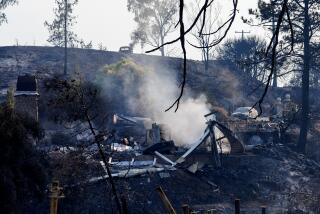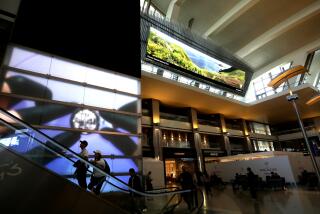She Could Never Do That? Yes She Could
When a Pan Am jet poised for takeoff blew an engine at Los Angeles International Airport last year, Linda DiCicco was in the hot seat. As a supervisor who oversees a dozen air traffic controllers at the world’s fourth-busiest airport, it was her responsibility to act. DiCicco dispatched emergency vehicles, called city operations and notified Terminal Radar Approach Control of the potential emergency--all in two minutes.
DiCicco doesn’t view the incident as routine, but as a 20-year air traffic control veteran, she took it in stride. The plane aborted takeoff, passengers exited safely and air traffic continued. “I did my job,” she said.
Her workplace is the cab of an 800-square-foot tower with a spectacular view, literally from the desert to the sea. The soundtrack is a constant buzz of low-level noise, as controllers and their equipment communicate with aircraft. The responsibility is immeasurable.
“This just isn’t a job for everyone,” DiCicco said. “You have to have the ability to be able to listen to three, four, five things at a time.”
Her career began 20 years ago when the Marine Corps recruited the then-18-year-old from the suburbs of Minneapolis by showing her photographs of uniformed personnel engaged in dynamic careers. One shot was of an air traffic controller--a woman. “That looks pretty neat,” DiCicco recalled saying. The recruiter’s response: “No, you could never do that.”
But in boot camp DiCicco scored so high on an aptitude test that the Marines gave her the choice of any aviation job. Air traffic control, she insisted. She trained full time for four months with 25 others. By graduation, only eight were left.
DiCicco directed military air traffic at a Yuma, Ariz., facility for four years. After she left the military, she rose through the civilian air traffic controller ranks to gradually busier airports and supervisory positions in Southern California.
Technology is a daily companion. Air traffic controllers routinely monitor radar screens and other devices that track aircraft movement. Huge mainframe computers manage the systems that link into their monitors. But although air traffic controllers use computer-based technologies constantly, the positions demand little computer expertise and no college training.
The FAA trains controllers in the intricacies of aviation, at its expense. This month it is retraining 10,000 controllers who handle final approaches, landings and departures. Those who prove they have the right stuff typically stay at it for 20 to 30 years.
Competition to join the ranks is grueling. Only 3% survive to become controllers among those who pass several screening measures and an aptitude test that assesses a candidate’s skill with spatial relationships, quantitative reasoning and the ability to think fast.
It’s also a young person’s game. The FAA doesn’t accept any candidates older than 30, and mandatory retirement age is 56.
Air traffic control isn’t a growing field, but applicants pour in, lured by substantial salaries and aviation’s glamour. The FAA employs about 17,000 air traffic controllers in the U.S., a total that hasn’t changed much in the last 10 years. In 2001, however, demand could jump--that date marks the 20-year anniversary of President Reagan’s firing of striking air traffic controllers. Many of those who started work after the mass firing will become eligible for retirement.
Controllers at busy towers like the one at LAX earn an annual base salary of $66,000. A supervisor pulls in more than $100,000, plus a benefits package. DiCicco insists the attraction goes beyond money.
“I like the instant gratification,” she said. “Every day, pilots say thank you, and I know I’ve just done a good job.”
(BEGIN TEXT OF INFOBOX / INFOGRAPHIC)
AT A GLANCE
* Name: Linda DiCicco
* Job: Operational supervisor at the Los Angeles International Airport control tower
* Employer: Federal Aviation Administration
* Education: Completed FAA air traffic training at the Mike Monroney Aeronautical Center in Oklahoma City, 1983. General studies at University of Minnesota in Minneapolis, 1978-79.
* Home: Fullerton
More to Read
Inside the business of entertainment
The Wide Shot brings you news, analysis and insights on everything from streaming wars to production — and what it all means for the future.
You may occasionally receive promotional content from the Los Angeles Times.










